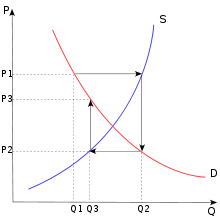The cobweb model or cobweb theory is an economic model that explains why prices might be subject to periodic fluctuations in certain types of markets. It describes cyclical supply and demand in a market where the amount of production must be chosen before prices are observed. Producers’ expectations about prices
Are assumed to be based on observation of previous prices. NocolaKaldor analyzed the model in 1934, coining the term ‘cobweb theorem’.
The models
The cobweb model is based on a time lag between supply and demand decisions. Agricultural markets are a context where the Cobweb model might apply, since there is a lag between planning and harvesting. Suppose for unexpectedly bad weather, farmers go to market with an unusually small crop of strawberries. This shortage, equivalent to a leftward shift in the market’s supply curve, results in high prices. If farmers expect these high price conditions to continue, then in the following year, they will raise their production of strawberries relative to other crops. Therefore, when they go to market the supply will be high, resulting in low prices. If they then expect low prices to continue, they will decrease their production of strawberries for the next year, resulting in high price again.
This process is illustrated by the diagrams on the right. The equilibrium price is at the intersection of the supply and demand curves. A poor harvest in period 1 means supply falls to Q1, so that prices rise to p1. If producers plan their period 2 productions under the expectation that this high will continue, then the period 2 supply will be higher, at Q2. Prices therefore, fall to p2 when they try to sell all their output. As this process repeats itself, oscillating between periods of low supply with high prices and then high supply with low prices, the price and quantity trace out a spiral.
Page no 83
In either of the first production plan, the combination of the spiral and the supply and demand curves often looks like a Cobweb; hence the name of the theory is Cobweb model.

Figure: The Cobweb model
 Educative Site Free Online Academic Courses Tutorials, Books with enough questions and answers
Educative Site Free Online Academic Courses Tutorials, Books with enough questions and answers